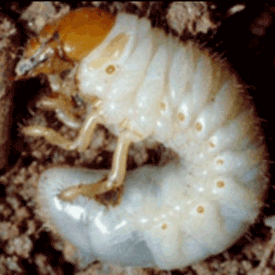A Plus Fertilizing
Residential and Commercial

If you are having an issue with this type of insect, please contact us to help you make the right choice for your property.
insects
White Grubs
Grubs live in the soil over winter and as the temperatures start to rise so do the grubs. The grubs will feed on the roots of the grass until pupating into an adult (a beetle). This takes place through the months of June and July. The adult beetles will begin laying eggs in the turf and these eggs will hatch in late summer to fall. This is a time where grubs can be most harmful due to the fact that the lawn is slowing down and this gives it less of a chance for recovery.
Grub damage can start off looking like drought damage. One for sure sign of grub damage is that the turf will peel back like a carpet. You may also see damage from moles, skunks, birds, etc. But please note that a moles favorite food is earthworms so it is not necessarily always grubs. As fall temperatures start to drop the grubs will once again hibernate under the frost an wait for warm spring to start all over again.
- They are beetle larvae.
- Creamy white in color.
- They have six legs.
- C-Shaped.
- Their heads range from tan colored to rusty brown.
Prevention Tips
- Throw away any beetle traps or beetle bags. Please understand that these bags have pheromones in them attracting the beetles to the bag. Once the beetles enter the bag they die. But it is the journey to the bag that the beetles will be laying eggs all through the lawn.
- Scouting is essential in keeping a healthy lawn. Strangely enough beetles are a lot like humans. We want the absolute best we can offer our offspring and want to provide them with all the tools for survival. That is exactly what beetles do; they are looking for healthy, weed free lawns. Thriving grass is a grubs dream. This gives them their best chance for survival. A healthy lawn is a target for beetles and grubs, so scouting regularly gives you the best chance to nip them in the bud before real damage can occur.



Contact Us